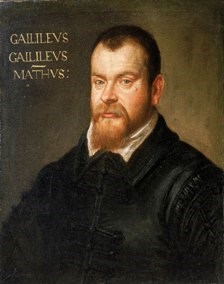
I've got to admit: Google's Galileo logo on Tuesday was pretty cool. The site explained that it celebrating the "400th Anniversary of Galileo's First Telescope."
Well, that's accurate in its generality if not in the specifics. On August 25, 1609, Galileo first demonstrated his "spyglass" to officials in Venice. He apparently created it sometime earlier.
Yes, that's an annoying nitpick that completely misses the point of the celebration. Let's call Google close enough. But far less accurate are many of the other big "facts" that went through people's minds when they heard of the anniversary this week.
1. Galileo invented the telescope.
No. Others had figured out that if you put two lenses together you could see distant objects. Dutch lensmaker Hans Lipperhey applied for a patent in 1608. Galileo's was better. But it wasn't his first. As he later wrote:
About ten months ago a report reached my ears that a certain Fleming had constructed a spyglass by means of which visible objects, though very distant from the eye of the observer, were distinctly seen as if nearby. [The report] caused me to apply myself wholeheartedly to inquire into the means by which I might arrive at the invention of a similar instrument. This I did shortly afterwards, my basis being the theory of refraction. First I prepared a tube of lead, at the ends of which I fitted two glass lenses, both plane on one side while on the other side was one spherically convex and the other concave. Then placing my eye near the concave lens I perceived objects satisfactorily large and near, for they appeared three times closer and nine times larger than when seen with the naked eye alone. Next I constructed another one, more accurate, which represented objects as enlarged more than sixty times. Finally, sparing neither labor nor expense, I succeeded in constructing for myself so excellent an instrument that objects seen by means of it appeared nearly one thousand times larger and over thirty times closer than when regarded with our natural vision.
Well, eventually, anyway. National Geographic describes the version that Galileo took to the Venetian leaders like this: "Made of wood and leather, Galileo's telescope had eight-times magnification, a convex main lens, and a concave eyepiece that—unlike other telescopes of the period—presented the image the right way up."
By the way, the word telescope wasn't used until 1611.
2. So he didn't invent it, but he was the first to use it to look into space.
Actually, he told the Venetian officials that it was for terrestrial purposes. Oxford science historian Alan Chapman told National Geographic, "Galileo [took] a number of senators up to one of the bell towers in Venice where you can see ships out in the lagoon." At the time, Venetian vessels were being attacked by the Turks. As Saswato R. Das wrote in The New York Times this week, the telescope let watchmen "see ships sailing into Venice's harbor a full two hours before they became visible to the naked eye."
Thomas Harriot meanwhile, was using a telescope to make sketches of the moon's surface. If you wanted to celebrate that 400th anniversary, too late: it was July 26.
3. Well, "firsters" often aren't first. The important thing is that when he did look into space and published his findings that the earth really wasn't the center of the universe, it caused outrage throughout Christendom.
"It's tempting to see it representing a fundamental break in the relations between science and religion, but I don't think it represented anything of the sort," says science historian Ron Numbers, editor of the recently published Galileo Goes to Jail and Other Myths About Science and Religion (Harvard University Press). "In fact, at the time, it aroused relatively little interest. It was only in later decades and centuries that it came to be seen as a representation of what supposedly happens to scientific pioneers when they dare to try to correct the church's teachings."
In Sightings, Karl E. Johnson recently summarized some of the other facts that get in the way of the science vs. faith narrative.
Galileo's Dialogue Concerning the Two Chief World Systems, the source of controversy, previously had been read and approved by the Church's censors; and Pope Urban VIII, who presided over the trial, was Galileo's friend and admirer. Consider also: prior to the trial, Galileo stayed in the Tuscan embassy; during the trial, he was put up in a six-room apartment, complete with servant; following the trial, his "house arrest" consisted of being entertained at the palaces of the grand duke of Tuscany and the Archbishop of Siena. Galileo, apparently, was no ordinary heretic.
4. Friendly or not, the Roman Catholic Church thought Galileo's science contradicted Scripture and therefore could not be true! That's why Cardinal Bellarmine ordered Galileo to back away from Copernican theory.
Well, there is this quote:
In the learned books of worldly authors are contained some propositions about nature which are truly demonstrated, and others which are simply taught; in regard to the former, the task of wise theologians is to show that they are not contrary to Holy Scripture; as for the latter (which are taught but not demonstrated with necessity), if they contain anything contrary to the Holy Writ, then they must be considered indubitably false and must be demonstrated such by every possible means.
But that came from Galileo. Cardinal Bellarmine, a friend of Galileo, said this:
If there were a true demonstration that the sun is at the centre of the world and the earth in the third heaven, and that the sun does not circle the earth but the earth circles the sun, then one would have to proceed with great care in explaining the Scriptures that appear contrary, and say rather that we do not understand them than that what is demonstrated is false. But this is not a thing to be done in haste, and as for myself I shall not believe that there are such proofs until they are shown to me.
At issue were biblical texts that said the earth "cannot be moved." But a geocentric view of the universe owed more to the Greek mathematician Ptolemy than to Scripture.
5. Bellarmine or no, the church declared Galileo a heretic and had him tortured.
Well, that Galileo believed in the authority of Scripture is not to say that he and the Church agreed. He was, after all, forced to recant his belief in heliocentrism. "Who can doubt that it will lead to the worst disorders when minds created free by God are compelled to submit slavishly to an outside will?" he wrote "When we are told to deny our senses and subject them to the whim of others?"
But Voltaire's line that Galileo "groaned away his days in the dungeons of the Inquisition" (or Sam Harris's line that the church had a habit of "torturing scholars to the point of madness for merely speculating about the nature of the stars"? Not true.
As Numbers says:
Galileo suffered very little abuse at the hands of the Catholic Church. He was never tortured, he never faced death. In fact, he was never imprisoned. His penalty was house arrest at a pleasant villa on the outskirts of Florence, Italy.
Galileo's problems with the church stemmed far less from his astronomical and physical views than from his lack of diplomacy, and from his impertinence in trying to instruct the church on how to interpret Scriptures, as some Protestants had attempted to do in the previous century. Furthermore, in writing his controversial book, Galileo had the impertinence to attribute the Pope's views to a simple-minded character named Simplicius. This Pope [Urban VIII] had once been a patron of Galileo's and had supported his scientific efforts, so such a lack of diplomacy turned even the Pope against his one-time friend. ... There was never any indication in the court records of death being a possible penalty, and no other scientists were put to death for their scientific views.
Voltaire and Harris aside, the widespread belief that Galileo was tortured probably doesn't stem from malice toward religious belief. Rather, Maurice Finocchiaro argues in Galileo Goes to Jail, the Inquisition's declaration that it would subject Galileo to "rigorous examination" was probably understood by many contemporaries to mean he would be tortured, since that was a common euphemism at the time (though it was rare in Rome's Inquisition). Indeed, the record shows that there was an actual threat of torture. But all historical indications are that Galileo didn't suffer it.
6. Still, the bottom line is that Galileo was right and the church was wrong.
One of Galileo's main points in proving heliocentrism is that the earth's revolving around the sun is responsible for the tides. Similarly, he said the planets orbited the sun in perfect circles. Johannes Kepler, meanwhile, was right on both issues, and did a better job of showing evidence for his claims. He also, by the way, came up with a better way of making telescopes two years after Galileo's demonstration in Venice. But Galileo never adopted Kepler's improvements.
(For more on Galileo, Kepler, and their contemporaries, see Christian History's issue 76: The Christian Face of the Scientific Revolution)
Image: Painting of Galileo Galilei, 1605, by Domenico Robusti via Wikimedia Commons.

Support Our Work
Subscribe to CT for less than $4.25/month




























